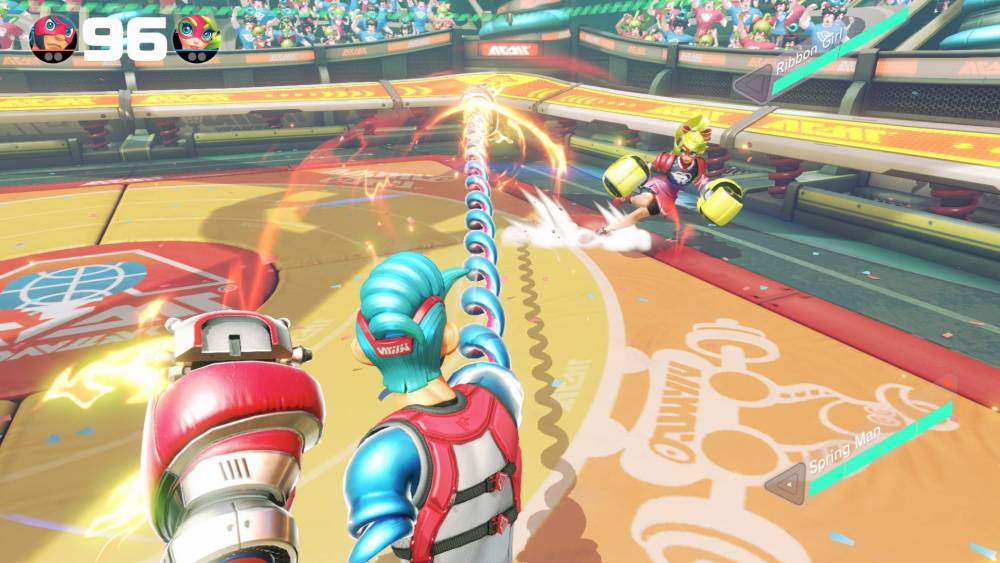ARMS Review
As a quirky Nintendo take on fighting games, Arms doesn't start off on the right foot. Its unique fighting mechanics are hard to get used to, and learning its unusual controls and cadence can initially be frustrating. But once you wrap your head around the basics, you begin to recognize what it take;Nintendo;83

As a quirky Nintendo take on fighting games, Arms doesn't start off on the right foot. Its unique fighting mechanics are hard to get used to, and learning its unusual controls and cadence can initially be frustrating. But once you wrap your head around the basics, you begin to recognize what it takes to win--clumsy punches become complex counters, and reacting to your opponent becomes instinctive as you settle into Arms' peculiar pacing. If you can get past its unavoidable learning curve, you'll find that Arms packs a fighting challenge that's unlike anything you've played before and is fun in ways you wouldn't expect.
Spring-loaded punches are the center of Arms' combat. Your fighter's arms have an incredibly long reach and take time to extend and retract. You are encouraged to play using motion controls with a Joy-Con in each hand, but that introduces a dissonance between the length of your in-game arm and your real life arm--by the time you're physically ready to punch again, your virtual arm is still on its return trip. It's easier to learn simple punches and timing with traditional controls, via the Pro Controller, which allow for more precise movements.
The timing of your punches, grabs, and blocks is critical--punch with your left arm too soon after punching with your right, and you'll be left open and vulnerable until they return. There's a rock-paper-scissors element to all of this, too: blocking stops punches, grabs overpower blocks, and punches deflect grabs. Being able to read the speed of a punch and block before it hits or side-step and throw a punch of your own is tricky, and learning how to do so is an unavoidable but frustrating hurdle. Arms can feel sluggish at first, but once you put in the time to understand its distinct give-and-take, you are freed up to confidently dodge, dash, and jump around the battlefield.
One of the great things about Arms is that you don't have to learn combos or other complex inputs that characterize most fighting games. However, beyond building a strong understanding of when to act and when to hold back, you will need to understand how the game's various equippable arms can impact your strategies and tactics in battle. You can pick out different arm configurations before entering a match, and they come with special properties, like disabling your opponent's arms or freezing their entire body in place. In addition to their individual physicality, each fighter has a unique ability: Twintelle can slow opponents' punches in midair, Ribbon Girl has a handy double jump, and Ninjara teleports while dashing, to name a few. So while Arms isn't a mechanically complex fighting game, it does require that you think on your feet and pay attention to who you're facing off against and the individual strengths each character brings into a match.
Yet, for all the knowledge and skill you acquire while continually playing Arms, you may find that your control scheme of choice has the biggest impact on your effectiveness in battle, even if both options come with notable caveats. Motion controls lack the precision of playing with a Pro Controller, but the person playing with analog sticks will have to manage curving punches and moving around with the same stick--a less than ideal scenario. Nonetheless, it's rare that a person throwing punches in real life manages to beat the player with both hands on a stationary controller.
One of the great things about Arms is that you don't have to learn combos or other complex inputs that characterize most fighting games.
Arms is without a doubt at its best with two players facing off using the same controls. Single-player Arms is a little less exciting, with a sharp difficulty curve and the loss of a living, breathing adversary, the absence of which partially deflates the otherwise fascinating combat. Like with any competitive game, playing online is valuable for understanding the meta and which characters are considered top-tier; as for local multiplayer, it's fun (if not a little silly) to flail about in front of the TV with someone else vying for the crown.
With or without a human opponent, you can hop into extra modes to try out your moves under new circumstances, such as target practice or Arms-style volleyball. These diversions are better as warm-ups or palette cleansers between fights--they're treated like mini-games, and don't necessitate the same adaptability as fights themselves. Once you figure out the best way to win at volleyball, for example, you won't have to change your strategy much to continue winning.
Arms is a strong, substantial fighting game that takes a while to really hit its stride. Its barrier to entry is unlike anything else in the genre, but it's one worth tackling in order to get at the game's fascinating take on fighting. It may not have the same skill requirement as other fighting games, but the flexibility and fast thinking it requires secures it as one that works on its own terms and opens the genre up to a wider audience.
Source: https://www.gamespot.com/reviews/arms-review/1900-6416696/